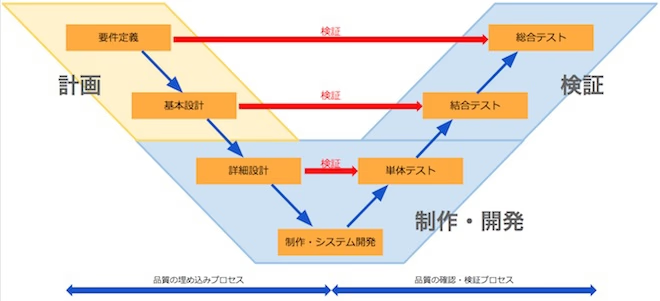こんにちはプロデュース部の上井です。
インターネットを取り巻く環境が急激に変化し、サイト構築において多岐にわたる分野の技術に関する知見と対応力が求められるようになっています。そのため、サイトリニューアルのプロジェクトでは、何かしらの課題を残してしまうことが多くなってきているように感じます。
もちろん、制作側の問題もありますが、クライアント側のWebマスターが「ここを理解しておいてもらえると、スムーズに進められたのに」と思うことがあります。
Webリニューアルのプロジェクトをスムーズに進めるには、クライアント側のWebマスターと制作側のプロジェクトマネージャーの協調が必要です。制作側が、クライアントの要望を理解しプロジェクトチームを統制できていることが最も重要であることに違いありません。しかし、制作・開発プロジェクトをスムーズに進めるには、クライアント側の理解、協力が欠かせません。
クライアント側のWebマスターへ、発注者・受注者という関係性のみならず、プロジェクトチームを共に率いる者として押さえておいてもらいたいことを、6回の短期集中連載の形でお伝えしたいと思います。
連載予定(第3回以降のタイトルは仮題)
第1回:QCDの精度と予算 〜二段階発注のすすめ〜 (今回)第2回:計画フェーズの進め方(2019年1月下旬予定)
第3回:セキュリティ対応と保守・運用について
第4回:上流工程でのWebマスターの役割と設計者に求められるスキルについて
第5回:プロジェクト規模とリソースについて
第6回:ウォーターフォールモデルとアジャイル開発
予算トラブルはなぜ起こるのか
コーポレートサイトのリニューアルでは、制作会社を指名コンペ形式で選定するのが一般的になってきています。
そして、コンペ提案時の見積りに基づいて一括請負による受発注とされるケースが多く見られますが、この場合、制作会社はプロジェクトの最上流で見積りを行うことになります。
<図>一括請負の受発注

サイトリニューアルの見積りを行うには、現在のサイトの内容を把握することが重要です。しかし、コンペ提案段階で入手可能な資料や外部からのサイト調査では、十全に把握することは大変困難です。
発注者側もこの段階では、サイト調査のための運用サーバーへのアクセスを制作会社に許可することはできないでしょう。
前提条件が不確かなまま見積りを行う場合、プロジェクト開始後に作成対象ページ数が膨らんだり、要求仕様の難易度が高くなることに備えてバッファを持たせる必要があります。
しかし、指名コンペ形式で業者選定が行われる場合、競合を勝ち抜くためにコンペ参加企業側はできるだけバッファを小さくした見積りを提示することになることは想像に難くないと思います。
その際、制作条件に数量の上限を設けたり、比較的必要性が低いと考えられるコンテンツの削除や様々な開発仕様の制限を設けた見積りとするのが一般的です。
プロジェクト開始後、詳細な現状把握と作成仕様の検討によって上記の制作条件を超えた対応が必要となった場合、費用とスケジュールの見直しが必要となり、発注者と制作会社の間でのトラブルにつながることがあります。また、制作・開発工程やテスト工程で要求仕様の変更を求められることも散見されます。
手戻りにより、作業工数が膨らんだり、対応スケジュールが逼迫したり延長が必要となったりという問題もありますが、アサインした技術者では対応しきれない技術要件への変更の場合、確保した技術者をリリースして改めて要員の再手配が必要となるなど、深刻な問題につながる可能性も出てきます。
<図>修正見積りの発生

コンペによるプロジェクトの場合、初期の見積りから少なくとも3割程度の費用アップとなるケースが多いと感じています。これは先にお話したように初期見積りは、コンペを勝ち抜くため対応範囲に制限を設けたものとなっているためです。
修正見積りにより、当初見積りの1.5倍〜2倍に予算が膨らむといったことが往々にして起こっています。
もちろんクライアント側でも、プロジェクト着手後の要件追加や設計変更に備えて、発注額に対して余裕をもった予算を組まれていることと思います。しかし、倍半分ものブレとなると容易に許容できるものではありません。
二段階発注のすすめ
そこで推奨したいのが、「計画フェーズ」と「構築フェーズ」の二段階発注です。
・計画フェーズ:要件定義、基本設計
・構築フェーズ:詳細設計、制作・開発、テスト
<図>計画フェーズと構築フェーズの二段階発注

サイトリニューアルのプロジェクトを開発工程モデルのV字モデルで示してみると、大きく「計画フェーズ」と「構築フェーズ(制作・開発・検証)」の2つの工程に区分けることができます。
<図>V字モデル

基本設計完了時に改めて見積りを行うことで、「制作・開発・検証」工程の見積り精度を高め、見積り変更のリスクを軽減させることが可能となります。
これは前回お話した、システム開発、建設業界で標準的に行われている進め方と同じです。
<図>システム開発の工程

<図>建設業界の工程

※公共事業では、設計・施工分離の原則により契約3と4が分離発注となるのが一般的であるが、近年では施工者が持つ固有技術の活用を目的として、契約3と4を一括発注するケースもある。</span>
QCDの精度と見積り
サイトリニューアルのプロジェクトを「計画フェーズ」と「構築フェーズ」の二段階で考えるのは開発工程モデルの構造に適ったものですが、予算を正確に把握するために必要な見積りの精度の点からも望ましいと考えます。
コンペ提案時(プロジェクト着手時)と基本設計完了時のプロジェクトのQCDの精度と見積り手順を確認してみます。
1. コンペ提案時
続いて、プロジェクト着手前となるコンペ提案時や一括請負による契約時の見積りの算出手順と精度について確認します。
・サイト設計 :
リニューアル後のサイトマップの作成する。(詳細な調査前の精度)各画面の作成仕様を検討し、概要を決める。
・画面設計 :
サイトの階層、コンテンツの分類に応じて、基準となる画面レイアウトを作成する。(主要画面のみ)画面レイアウトおよび画面構成要素のサイト内の各ページへの適用方針を検討し、概要を決める。
・システム設計 :
CMSやフォームなどシステム化する範囲を定め、開発仕様について仮決めする。
・基本デザイン :
サイト全体の基調デザインを作成する。(ラフデザイン)サイトの階層、コンテンツの分類に応じて、基準となる画面のデザインを作成する。(主要画面のみ、ラフデザイン)
上記のとおり、コンペ提案時の見積りの基準となるQuality(仕様)は、プロジェクトの範囲・数量を把握できていません。
そのため、この段階の推計値に基づいた積算での見積り参考として、過去に実施した類似案件の実績を元に、プロジェクト規模の比較により推計した見積りを提示することになります。
2. 基本設計完了時
サイトリニューアルのプロジェクトにおいて「基本設計」の工程では、下記内容の設計を行います。
・サイト設計 :
リニューアル後のサイトマップ(制作範囲の全ページを示す)の作成および各画面の作成仕様を決定する。
・画面設計 :
サイトの階層、コンテンツの分類に応じて、基準となる画面レイアウトを作成する。画面レイアウトおよび画面構成要素のサイト内の各ページへの適用ルールを決定する。
・システム設計 :
CMSやフォームなどシステム化する範囲を定め、開発仕様を決定する。
・基本デザイン :
サイト全体の基調デザインを決定する。サイトの階層、コンテンツの分類に応じて、基準となる画面のデザイン、画面構成要素のデザインを作成し、適用ルールを決定する。
基本設計では、プロジェクトの範囲と制作仕様を計画し、設計図書にとりまとめます。これにより、サイト構築の全体数量と作成仕様(難易度)が決まります。
全体数量と難易度が決まれば、構築に必要となる要員を計画し、作業工数を積算することが可能となります。
この要員計画と工数の積算結果に基づいて、工程計画を立案し、費用を算出します。
・Quality(仕様) :構築フェーズの全体数量、作成仕様(難易度)の決定。
・Cost(費用) :「Q:仕様」に基づき、要員計画を決定。費用を算出。
・Delivery(工期) :「Q:仕様」に基づき、工程計画を決定。
上記のとおり基本設計の完了をもって、プロジェクト対象範囲の全体数量、作成仕様(難易度)が定まり、費用、工期を計画、積算可能となります。
短期集中連載の第1回は「QCDの精度と予算〜二段階発注のすすめ〜」と題して、プロジェクトを大きく「計画フェーズ」「構築フェーズ」の2つの工程に分解する、二段階発注のメリットについてお話しました。
「基本設計」の工程は、サイト制作の仕様を決めていくことと合わせて、構築フェーズの工期、費用を定める、プロジェクトの中でも最も重要な工程であるといえるでしょう。
次回は、「第2回:計画フェーズの進め方」と題して、基本設計の工程において、クライアント側のWebマスターと、制作会社の協働の重要性についてお話しします。
